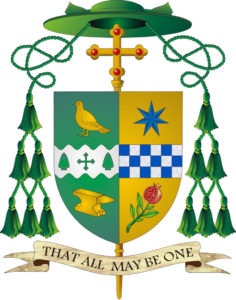
Practicing Faith, Hope, and Love: Living the Virtues Together in Tough Times
A Pastoral Letter by Bishop David J. Bonnar to the Priests, Deacons, Religious, and Lay Faithful of the Diocese of Youngstown
Solemnity of Pentecost, May 28, 2023
Copyright © 2023 Roman Catholic Diocese of Youngstown. All Rights Reserved.
ABOUT THE COVER ART
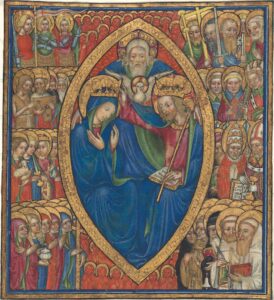
Coronation of the Virgin with the Trinity and Saints, c. 1440 Olivetan Master (artist) Lombard, active c. 1425 – c. 1450 Public Domain Open Access Image. Courtesy National Gallery of Art, Washington, D.C.
The virtues of faith, hope, and love are often evoked through portrayals of the Divine Trinity, because the virtues “dispose Christians to live in a relationship with the Holy Trinity . . . God known in faith, God hoped in and loved for His own sake” (Catechism of the Catholic Church, no. 1840). The cover art can remind us that the virtues and the entire Christian life, exemplified so beautifully in Mary and the Communion of Saints, flows from the life of God. The art was designed for a 15th century psalter, a reminder that our living of Christian virtues is rooted in prayer.
Scripture texts in this work are taken from the New American Bible, revised edition © 2010, 1991, 1986, 1970 Confraternity of Christian Doctrine, Washington, D.C. and are used by permission of the copyright owner. All Rights Reserved. No part of the New American Bible may be reproduced in any form without permission in writing from the copyright owner.
Table of Contents
Introduction: Practicing Faith, Hope, and Love | Tough Times: Tough People | Availability of Clergy and Lay Ecclesial Ministers | Impact on Parishes | Opportunities
Chapter One: A Personal, Communal, and Active Faith Amid a Crisis of Belonging | Faith as Gift and New Sight | Seeing as Jesus Sees | Challenges to Faith and the Need for Community | An Active Faith: A Life of Holiness and Responsibility | An Adult Faith | Practical Applications | Questions for Reflection and Discussion
Chapter Two: Living Together with Newfound Hope | Living Together with Newfound Hope | Easter Hope in Hard Times: Alleluia is Our Song | Hope and Prayer Life | Hope, the Parish, and the Liturgy | Hope and Vocations: Liturgy, Eucharistic Adoration, and Youth Ministry | Practical Applications | Questions for Reflection and Discussion
Chapter Three: The Power of Love | God is Love | Forgiveness and Mercy: The Fruits of Love | Love is Presence | Practical Applications | Questions for Reflection and Discussion
Conclusion | Prayer of Commitment

INTRODUCTION
PRACTICING FAITH, HOPE, AND LOVE

During the early days of my episcopate, I issued my first Pastoral Letter, “Confronting Darkness with the Light of Jesus Christ: Testify to the Light.” In that document, I invited us all to acknowledge the darkness of the time and to reclaim the light of our sacramental life in a world plagued by numerous threats to the human family and our earthly home. My vision for the Diocese of Youngstown, as articulated in “Testify to the Light,” included the following priorities: prayer, healing, communication, service, and joyful witness. These five actions require us to remove the bushel baskets of our indifference, intolerance, and selfishness and allow the light of Christ, present in each one of us as children of God, to shine forth as beacons of hope.
I have been blessed to see the priorities I outlined in “Testify to the Light” take shape and form to advance the people of God in our diocese toward a dynamic sense of mission. One of the first actions we undertook in response to “Testify to the Light” was a deanery needs assessment of how our parishes were working together, in each regional area, on acts of service and outreach. Working with Catholic Charities, our parishes also brainstormed new projects to serve those most in need. Recently, we also established an Office of Peace and Justice, as part of Catholic Charities, to continue to form our people in ways of service and advocacy on behalf of those most in need.
The deanery needs assessment is but one example of how our parishes, schools, and diocesan entities are embracing new forms of regionalization and collaboration to serve God’s people. Parishes throughout our diocese are working together on efforts that include youth ministry, young adult ministry, initiation of adults into the Catholic community, and much more. Among our diocesan ministries, we formed an integrated department of communications, bringing together our efforts in print, television, radio, multimedia, and social media–the new front door of the Church– with a new priority of reaching the peripheries and building a wider community. This includes the launch of The Catholic Echo website and magazine, which is now reaching all registered households in print, and even more online. As we push towards the future, we also must never forget our past, which is why I established a diocesan archives to professionally preserve and tell our story. Financially, the work of both Catholic Charities and the mission of the Church is sustained in an important way by our annual appeal, which we have renamed the “Annual Diocesan Appeal: One in Hope, One in Mission” to make clear that the appeal is mission-oriented, and that it supports all the ways our diocesan community lives the Church’s mission. While we are moving in a positive direction, we still face many challenges that draw shadows over our best attempts to reach out to the margins and engage with others. It is to these challenges that I now turn.
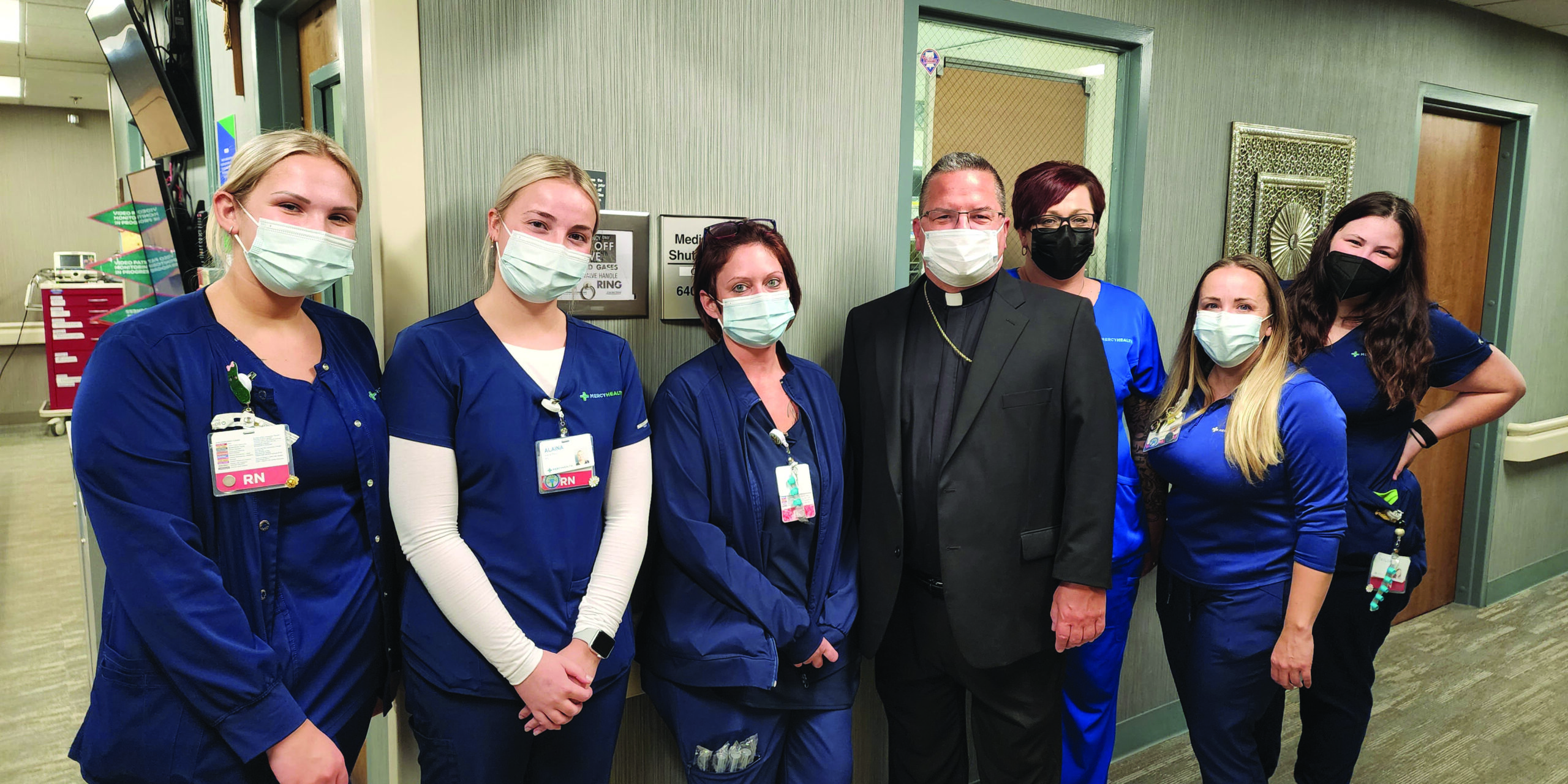
Tough Times, Tough People
Bishop Bonnar with healthcare professionals at St. Elizabeth Hospital, Youngstown. Photo by Justin Huyck.
In the City of Youngstown there is a building which houses a local business. As one drives by this establishment, one cannot help but notice a message painted on the side of the building which reads, “Tough times don’t last. Tough cities do.” This sign is a reminder to me that, while we are experiencing tough times, the people of our diocesan community – in all six counties – are “tough people.”
These have been tough times in Northeast Ohio, affecting us deeply in our diocese’s six counties of Ashtabula, Columbiana, Mahoning, Portage, Stark, and Trumbull. What was once an economically robust area has become an economically depressed community. The population has diminished. Unemployment has increased. Violence has escalated. Poverty continues to grow. Waves of addiction continue to affect our families and communities. Natural and man-made disasters have threatened our health and well-being, affecting the poor and vulnerable in disproportionate ways. The pandemic accentuated the suffering felt in our community, but we know that the economic, social, and cultural pressures have been with us for a long time. Indeed, these are—and have been—tough times.
In the past two years as your Bishop, I have seen over and over again that the people of Northeast Ohio are indeed, “tough people,” adapting to the changing times and supporting one another.
As Christians in this portion of the Lord’s Vineyard, we know that our toughness and endurance always flow from the faith, hope, and love we have in God.
God’s work, love, and revelation are always first, deeper than anything we might try to accomplish on our own.
The Catholic Church in the Diocese of Youngstown exists in the world and, therefore, is not immune to the influence of today’s culture, especially when it comes to attitudes and opinions about the practice of the faith. The diocesan, regional, and national summary reports from the ongoing Synod on Synodality highlighted many good things about Catholic life, including a sense of home that many experience in their parish, the presence of Christ in the liturgy, and important efforts of service and outreach. At the same time, the synod reports also revealed shadows, including a concern that many people question the Church’s authenticity when it comes to listening to the needs of the people. Others feel that the Church cannot read the signs of the times. Some are discouraged with liturgical experiences, finding them uninspiring and drab. There is a mood of suspicion in the Church that has led to a polarization reflective of our society in general. There are a growing number of Catholics who no longer practice their faith.

Availability of Clergy and Lay Ecclesial Ministers
Rev. Connor Hetzel at his ordination to the priesthood at St. Columba Cathedral. Photo by Robert Zajack.
The broader concerns expressed among the general Catholic population factor into the changing landscape of our local Church. In the Diocese of Youngstown, the number of priestly retirements far outweighs the number of ordinations each year. As of Spring 2023, the Diocese of Youngstown currently has 57 active priests, with four retiring this year and more expected in subsequent years. Even with the expected gift of new priests being ordained in coming years, the number of available diocesan priests will continue to remain low for the foreseeable future, along with a small but appreciated number of religious order priests serving our diocese.
For some time, we have been stretching our priests too thin, expecting them to serve in multiple ministries at once, accompany parish communities in more than one location, and juggle pastoral, administrative and diocesan responsibilities. Likewise, our lay ecclesial ministers find themselves stretched, including the seven diocesan pastoral associates who are currently serving in our diocese at my appointment, and all who serve in the name of the Church.
I am grateful to all priests, deacons, religious, and lay ecclesial ministers who witness to their love for God’s people through their shared ministry and sacrifice.
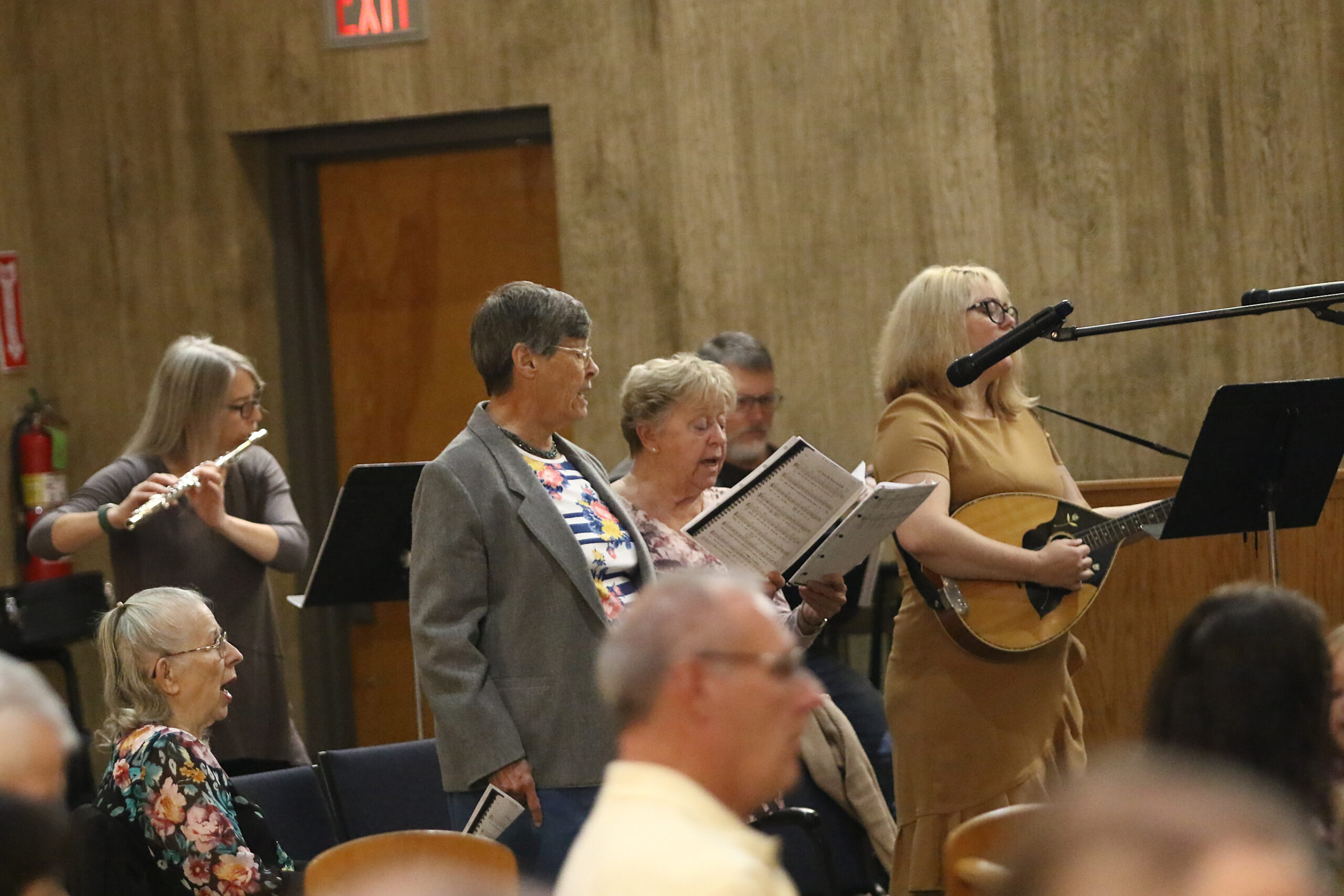
Impact on Parishes
Music ministry at St. Joseph Parish, Mantua. Photo by Ed Hall.
Parishioners have been deeply affected by changes in parish life, and it is clear that many are experiencing a disconnect from parishes and from the Church. By 2022, according to national statistics compiled by the Center for Applied Research in the Apostolate (CARA), the number of Catholics who attend Mass at least once a month had dropped to 36.6% and those attending weekly had dropped to 17.3%. We have certainly experienced this reality in the Diocese of Youngstown.
By 2022, the number of Catholics who attend Mass at least once a month had dropped to 36.6% and those attending weekly had dropped to 17.3%.
Center for Applied Research in the Apostolate (CARA)
A decline in Sunday Mass attendance naturally leads to a decrease in the financial resources necessary to maintain our parishes and to provide vital and life-giving ministries and services. Some church buildings have closed, with nine church buildings closing in my first two years as Bishop, along with one elementary school. Additionally, parishes are merging, with four mergers so far in my time as bishop. While necessary to ensure that we live for the needs of the future, and not in nostalgia for the past, we all understand these changes have an emotional and spiritual toll on all of us. Neighboring parishes are doing the best they can to share resources, cut costs, and keep parishioners engaged with the life of the Church. In this time of necessary change, I am heartened by the fact that many of our parishes have embraced a mission with no boundaries, inasmuch as they are sources of comfort and strength for the faithful, especially those on the peripheries of the Church and society.
At the same time, we must all acknowledge the elephant in the room: a gnawing ache at the loss of the conventional sense of parish that is familiar to us. Sometimes, this includes saying goodbye to beloved priests who have been re-assigned for the good of the Church. This sense of loss has compounded the grief that so many have experienced in their daily lives with the loss of family members, including those we lost due to the COVID pandemic, ongoing health concerns and struggles, the effects of addiction, financial pressures, and disasters.
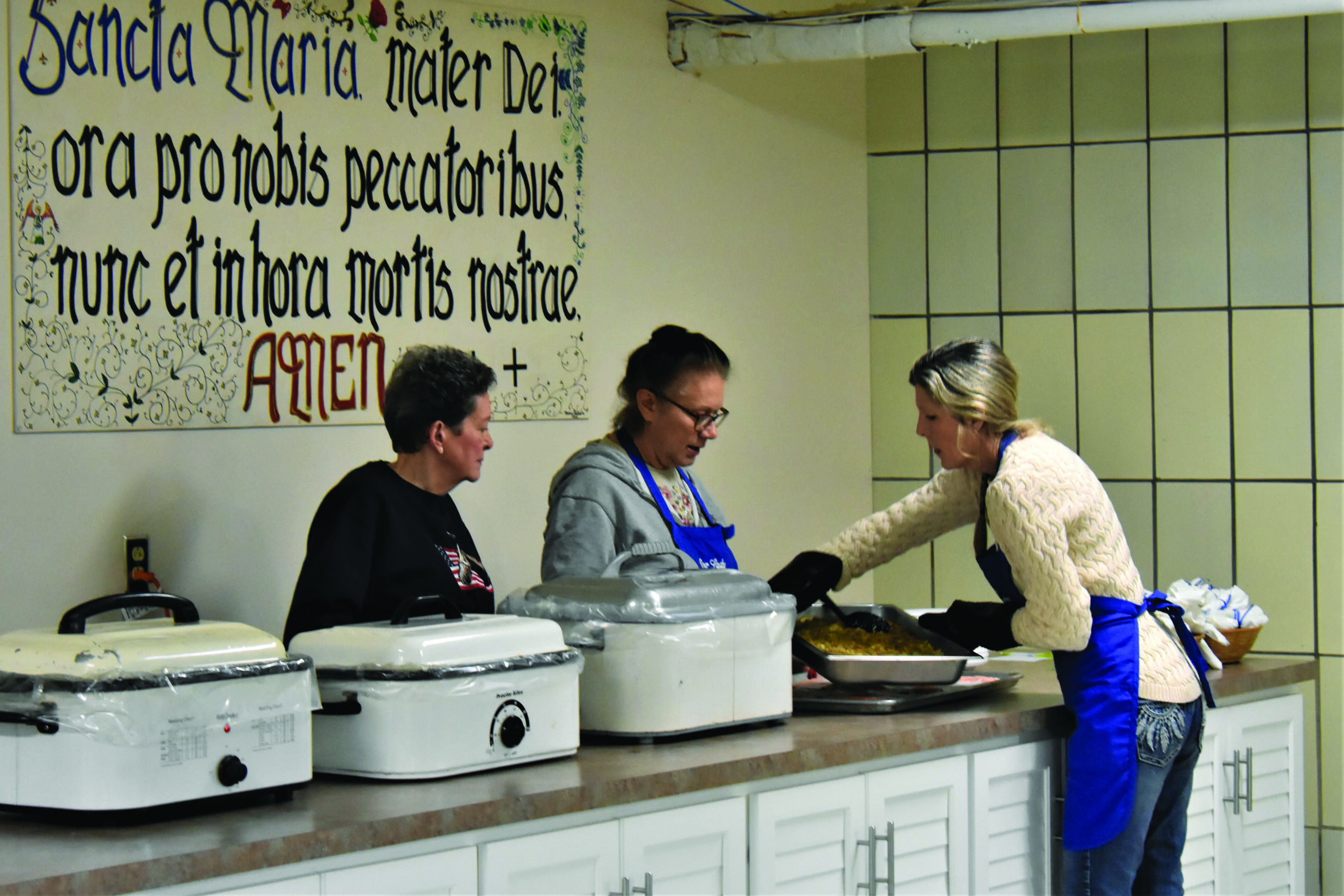
Opportunities
Community meal, in response to the 2023 train derailment, at Our Lady of Lourdes Parish, East Palestine.
Photo by Robert Zajack.
Amid the challenges, many feel stuck in grief, and it can be easy to lose heart and to cease testifying to the light. As people of faith, spiritually connected to one another through the sacrament of the Eucharist, we must face the realities of our present Church and discover new ways to engage and evangelize. However, we must also stand together outside the walls of the church to face the challenges and embrace the opportunities that surround us. I believe that opportunities are points of light, leading us through the darkness and into brighter days ahead.
In this second pastoral letter, I wish to build upon “Testify to the Light” and reflect with you on the opportunities we have as the Church here in the Diocese of Youngstown to live as missionary disciples in our time and place. The opportunities I have identified for the Diocese of Youngstown are inspired by the virtues found in St. Paul’s First Letter to the Corinthians: faith, hope and love (1 Corinthians 13:1- 13). I believe that these virtues are the answer to the present moment, showing the path through our challenges and grief. As this local Church celebrates 80 years, we need to acknowledge that it is these same virtues that have been integral in the lives of those before us. Today, we stand on the faith, hope, and love of the clergy, religious, and faithful who have walked before us. Throughout our anniversary year, we will thank Almighty God for these virtues which have been passed on from generation to generation and rededicate ourselves to practicing them in our daily lives.
Faith, hope, and love provide a framework for our active participation in the work of God and the mission of the Church. Faith, hope, and love are not only animated by tough people in the gritty toils of daily life, but also amplified within the context of a tender, caring Christian community where two or more are gathered (Matthew 18:20). Lived out in the daily actions of our lives, the virtues ultimately connect us to eternity and are rooted in sure faith that God’s gift in Jesus Christ is our salvation.
An active faith is always rooted in hope and expressed in love.

The Church traditionally identifies faith, hope, and love as the theological virtues that “dispose Christians to live in a relationship with the Holy Trinity. They have God for their origin, their motive, and their object – God known by faith, God hoped in and loved for his own sake” (Catechism of the Catholic Church, no. 1840). On the day of our Christian baptism, our story becomes inextricably linked to the Holy Trinity as we are baptized “In the name of the Father, Son, and Holy Spirit.” Every time we make the Sign of the Cross we acknowledge our relationship with the one God: Father, Son, and Holy Spirit. And we live this relationship out in the Church, which is one, holy, catholic, and apostolic in nature. It is the Sacrament of our salvation. We belong to a community who believe in the Father creator, we follow in the footsteps of Jesus our redeemer, and together we seek the help of the Holy Spirit, the paraclete especially in times of fear, worry, or weakness. The living out of this relationship is a matter of faith, hope, and love.
Image: From Coronation of the Virgin with the Trinity and Saints, c. 1440 Olivetan Master (artist) Lombard, active c. 1425 – c. 1450 Public Domain Open Access Image. Courtesy National Gallery of Art, Washington, D.C.
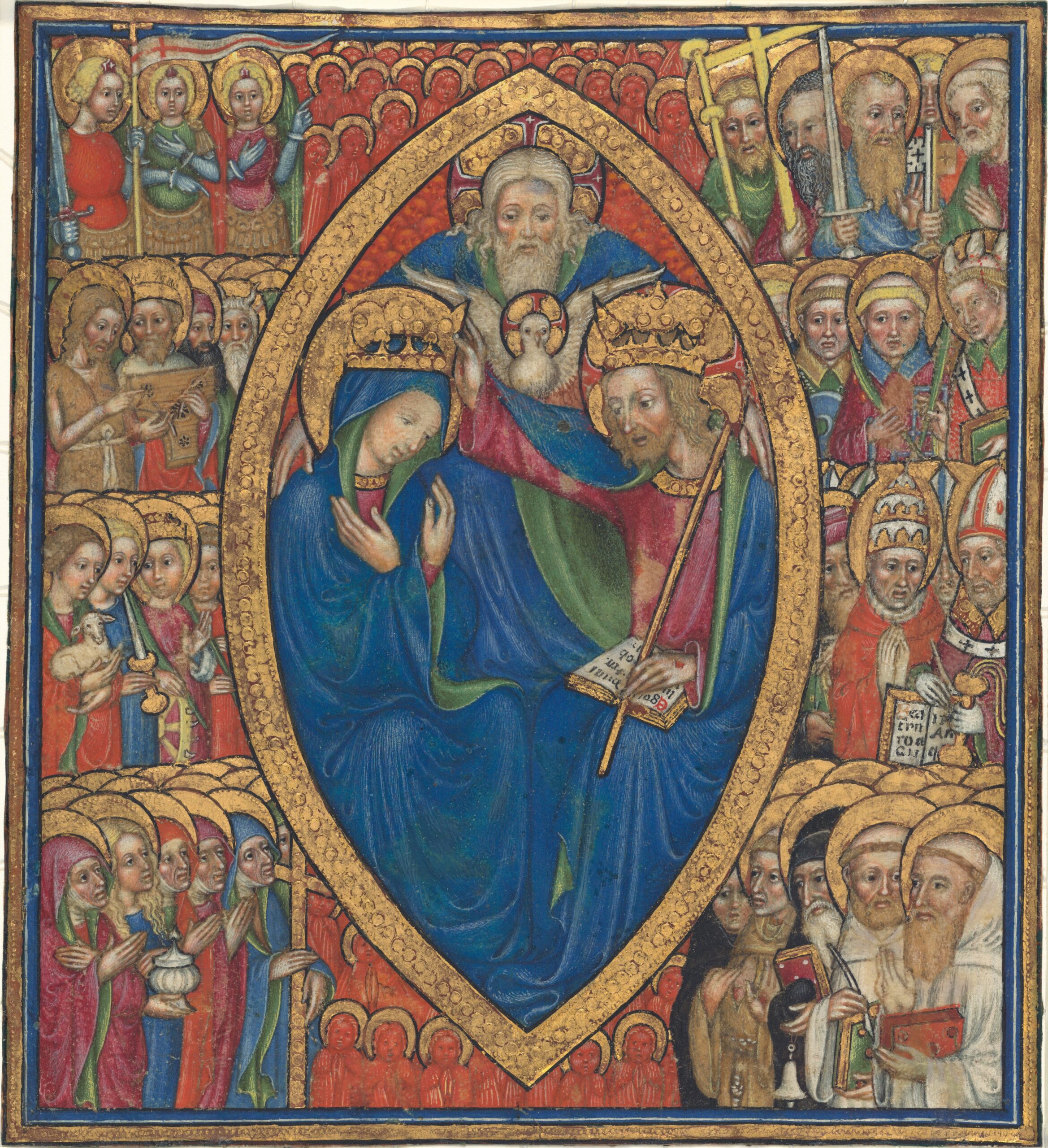
CHAPTER ONE
A PERSONAL, COMMUNAL, AND ACTIVE FAITH AMID A CRISIS OF BELONGING
From Coronation of the Virgin with the Trinity and Saints, c. 1440 Olivetan Master (artist) Lombard, active c. 1425 – c. 1450 Public Domain Open Access Image. Courtesy National Gallery of Art, Washington, D.C.
“FOR THROUGH FAITH YOU ARE ALL CHILDREN OF GOD IN CHRIST JESUS.“
GALATIANS 3:26

Faith as Gift and New Sight
In The Joy of the Gospel, Pope Francis expresses this dream for our Church:
“I dream of a ‘missionary option,’ that is, a missionary impulse capable of transforming everything, so that the church’s customs, ways of doing things, times and schedules, language and structures can be suitably channeled for the evangelization of today’s world rather than for her self-preservation.”
The Joy of the Gospel, no. 27
Here, I want to focus on how evangelization continues to be an urgent priority for each and every one of us personally. On the one hand, Pope Francis has invited each of us to understand ourselves as “missionary disciples”—each of us, by virtue of being baptized disciples of Jesus, is called to be an active agent of evangelization. “Every Christian is a missionary to the extent that he or she has encountered the love of God in Christ Jesus: we no longer say that we are ‘disciples’ and ‘missionaries’, but rather that we are always ‘missionary disciples’.” (“The Joy of the Gospel,” no. 120).
On the other hand, a central dimension of this missionary mandate, that we all have, is the assumption that we have, indeed, “encountered the love of God in Christ Jesus.” This may take more reflection for each of us, to identify how the love of God has touched us in the midst of our lives. This is why the new evangelization, promoted by Pope St. John Paul II, Pope Benedict, and Pope Francis, has put such a focus on the need we all have to renew our own personal faith. In “The Light of Faith,” Pope Francis reminds us of our classic Catholic understanding of faith as a supernaturally infused virtue that always begins with the gift of God’s grace, a fruit of the Holy Spirit moving within us, and involves our free response as we assent, surrender ourselves, and experience joy (see “The Light of Faith,” no. 7; “Dei Verbum,” Vatican II Dogmatic Constitution on Divine Revelation, no. 5; “Catechism of the Catholic Church,” nos. 153-165; “Directory for Catechesis,” no. 19).
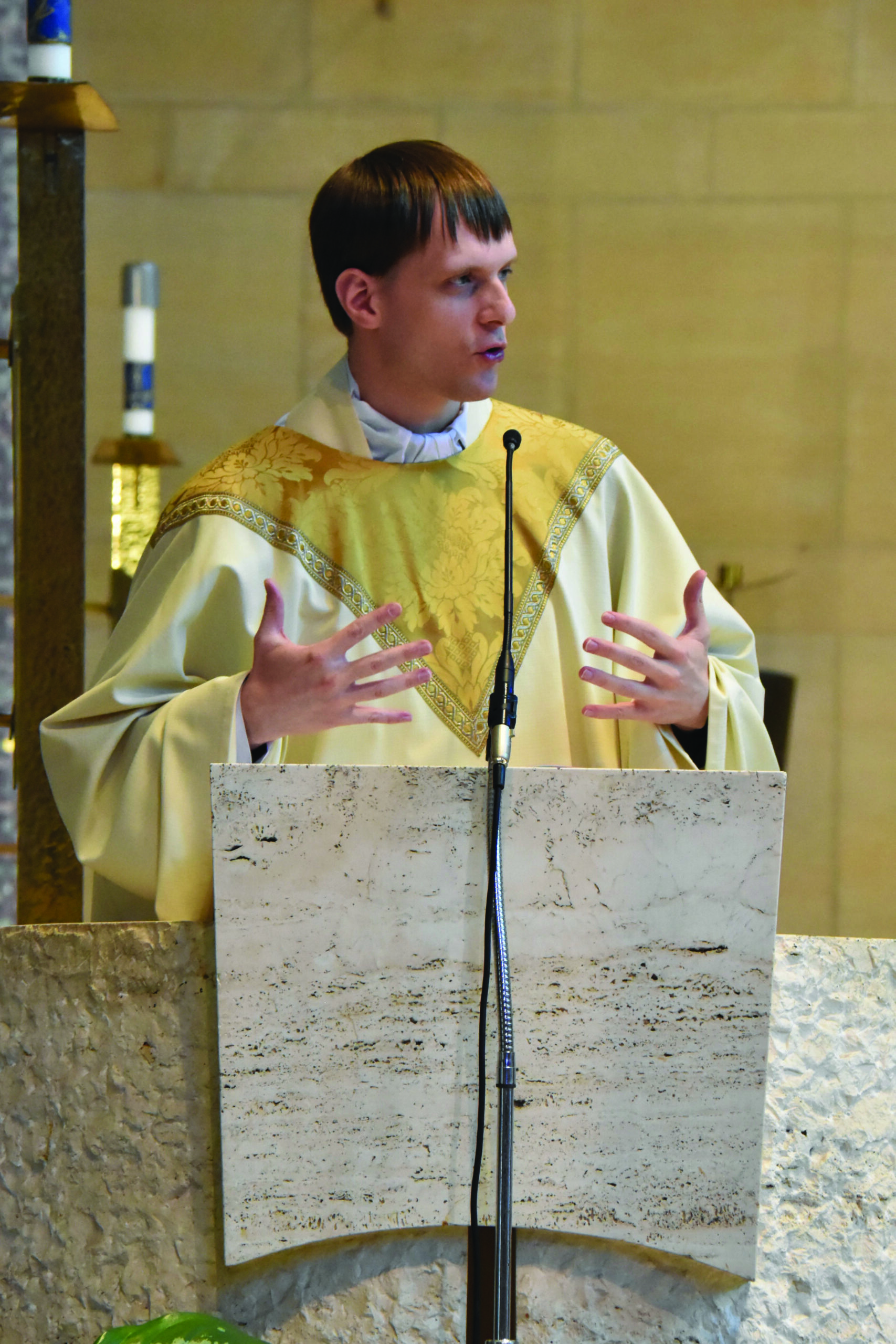
Seeing as Jesus Sees
Rev. Matthew Zwilling preaching a homily at St. Columba Cathedral. Photo by Robert Zajack.
Pope Francis goes on to offer an understanding of faith that both challenges and consoles us: “Faith does not merely gaze at Jesus, but sees things as Jesus sees them, with his own eyes: it is a participation in his way of seeing.” As Christians, we name Jesus’ way of seeing as the Kingdom of God: to see what Jesus sees is the first step to walking as Jesus walked, serving as Jesus served, loving as Jesus loves. When we have difficulty seeing goodness in our world or a sense of direction for ourselves, it is both comforting and challenging to embrace the sight of Jesus who “opens up new and inviting vistas for human experience” (“The Light of Faith,” no. 18).
But to see as Jesus sees, and therefore walk as Jesus walked, we need to admit that our sight sometimes needs to be corrected.
No wonder then that, according to our Gospel tradition, Jesus first began his ministry with stories of healing. Likewise, the Gospels pair Jesus’ acts of healing with his preaching. It is Jesus himself who heals us with his hands and the new way of life and salvation that he preached, so that we align our vision to his.
We experience this healing and new vision continually through the Church’s sacramental life, in which Christ’s presence transforms us through Word and Sacrament. For those of us who serve as priests and deacons, it is an awesome responsibility to embrace our role of preaching, recognizing the presence of Christ, the Light of the World, in this sacred act.
In 2022, as part of our diocese’s continuing formation program for clergy, we welcomed Rev. Richard DeLillio, retired homiletics professor from The Catholic University of America, to speak to our priests and deacons on preaching in the hopes of making us all better preachers. In his first presentation, Father Delillio referenced the healing of the blind man at Bethsaida (Mark 8:22-26). Jesus uses spittle, touches his eyes, and he is healed. Father Delillio defined preaching as an exercise which seeks to remove the scales from people’s eyes. While preaching is often viewed in the context of hearing, the goal is for the hearer to see and continue the path of ongoing conversion.
Faith is a gift expressed in a trusting surrender to this way that we have seen and heard, and an embrace of the path that we are now called to walk. A genuine disposition of faith is analogous to riding in a car and leaving the driving to God and allowing Jesus to take the wheel, so to speak.
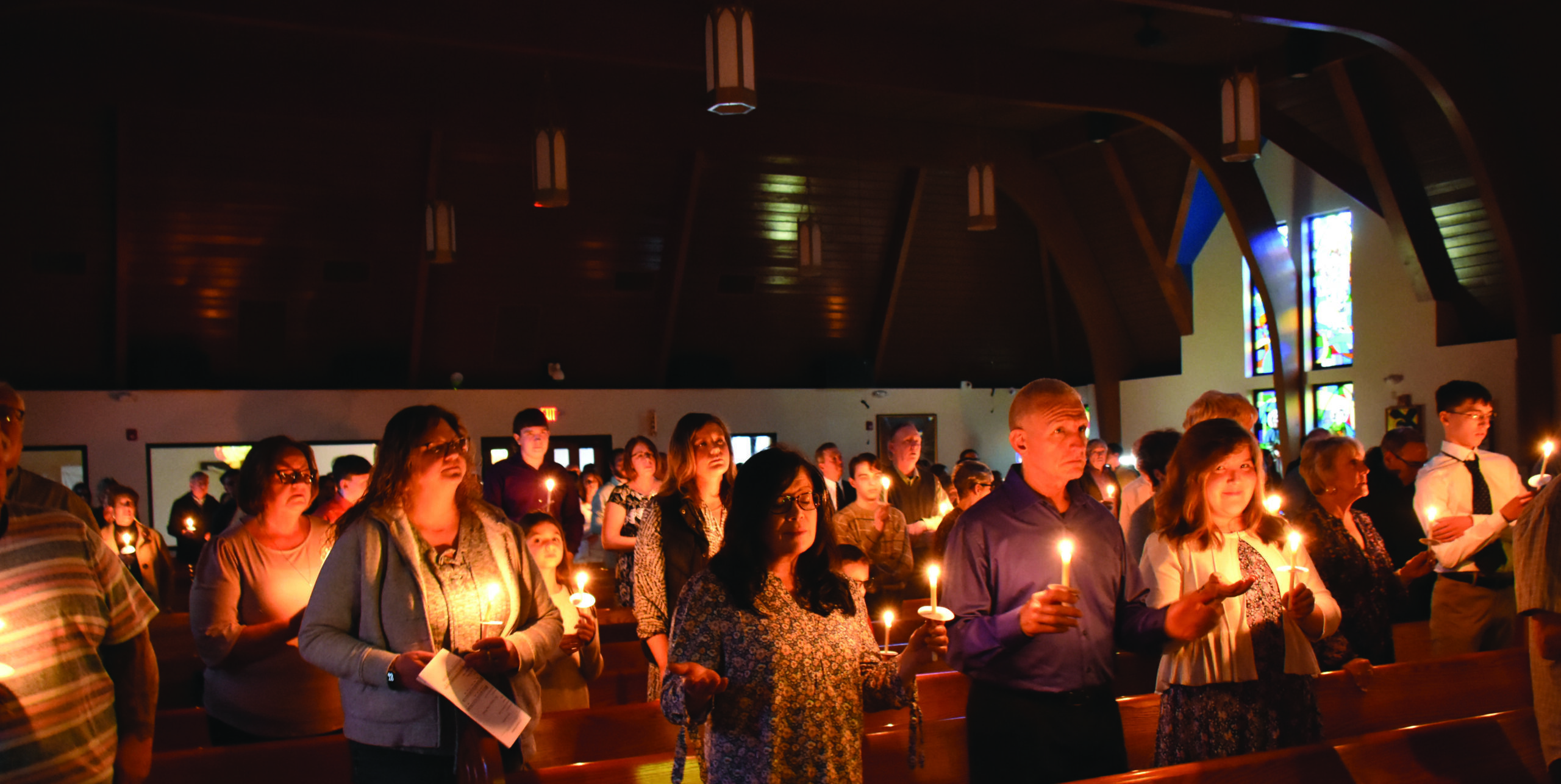
Challenges to Faith and the Need for Community
Easter Vigil at St. Jude Parish, Columbiana. Photo by Robert Zajack.
The circumstances of our lives can at times challenge and even make us doubt our faith, and it is in those times especially that we need community. Many can identify with the sentiments of the prophet Habakkuk who pleaded, “How long, O Lord? I cry for help but you do not listen! I cry out to you, ‘Violence!’ but you do not intervene” (Habbakuk 1:2). Then we ourselves cry out in our disillusionment, “Increase our faith” (cf. Luke 17:5).
Our faith needs community. Parishes are “the usual place in which the faith is born and in which it grows.”
Directory for Catechesis, no. 299
We become more immersed in the faith by belonging to a parish family where we are led by God’s Word and fed by the Sacrament, the Body and Blood of Christ. And when we fall to sinfulness and become broken, we find restoration and peace in the Sacrament of Reconciliation and start all over again.
Beyond the parish, there is the diocesan Church, tens of thousands gathered in faith led by the bishop who serves as a successor to the apostles. Then there is the universal Church with a billion and more sisters and brothers in faith, led and inspired by our chief shepherd, the Holy Father. Because so much of our experience of the Catholic community is lived out in parish life, we sometimes need reminders that our Catholic faith extends to the universal Church. Some of our Youngstown seminarians experienced this sense of the universal Church recently when they visited Rome with their brother seminarians from Cleveland and had a private audience with the Holy Father, Pope Francis.
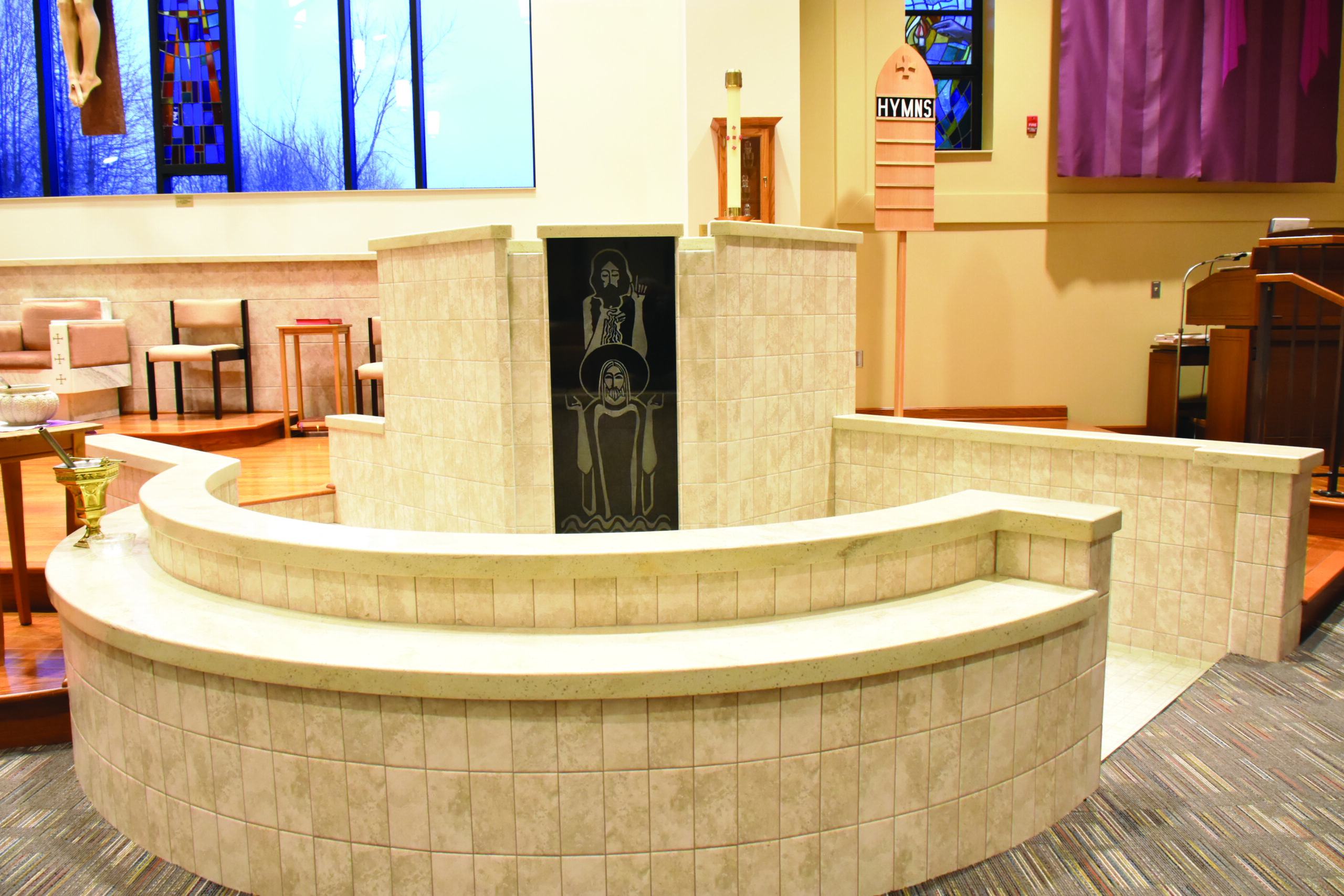
An Active Faith: A Life of Holiness and Reponsibility
Baptismal Font at St. Thomas the Apostle Church, Vienna. Photo by Brian Keith.
As Catholics, we must recover the fullness of our communal faith if we are to live our mission as a Church. We must also recover faith as an active responsibility, which we fulfill together within our own particular roles. Church is not simply a place we go to think with people who think like us; it is a community of disciples walking together in faith. Faith is not simply something of the head, but involves the whole body and soul. This is why the four pillars of the Catechism are holistic and involve the faith believed, prayed, celebrated, and lived: our Creed, Prayer, Sacraments, and Morality.
For humans, to belong is to accept responsibility. For Catholic Christians, to belong to Christ and to the Church is to accept responsibility for the mission of Christ and the Church. We are one Body of Christ, diverse in roles and gifts, belonging to Christ and to one another, co-responsible for the Church’s mission.
“For as in one body we have many parts, and all the parts do not have the same function, so we, though many, are the one body in Christ and individually parts of one another. Since we have gifts that differ according to the grace given us, let us exercise them . . .”
Romans 12:4-6
“Let us exercise them.” Active belonging is central to our sacramental practice, and our daily living, as Catholic Christians. It flows from our liturgical celebrations which expect our “full, conscious and active participation” (“Sacrosanctum Concilum,” Vatican II Constitution on the Sacred Liturgy, no. 14) by virtue of our baptism. The sacraments of initiation – Baptism, Confirmation, and Eucharist – incorporate us into the active life of the community, which is the life of Christ. Indeed, those who enter the Church as adults through the catechumenate (Order of Christian Initiation of Adults) are invited into an “apprenticeship in the Christian life” (“Directory for Catechesis,” no. 34; “Ad Gentes,” Vatican II Decree on the Mission Activity of the Church, no. 13)—not simply a learning with the head, but with the whole body through acts of service and the multi-faceted life of the community.
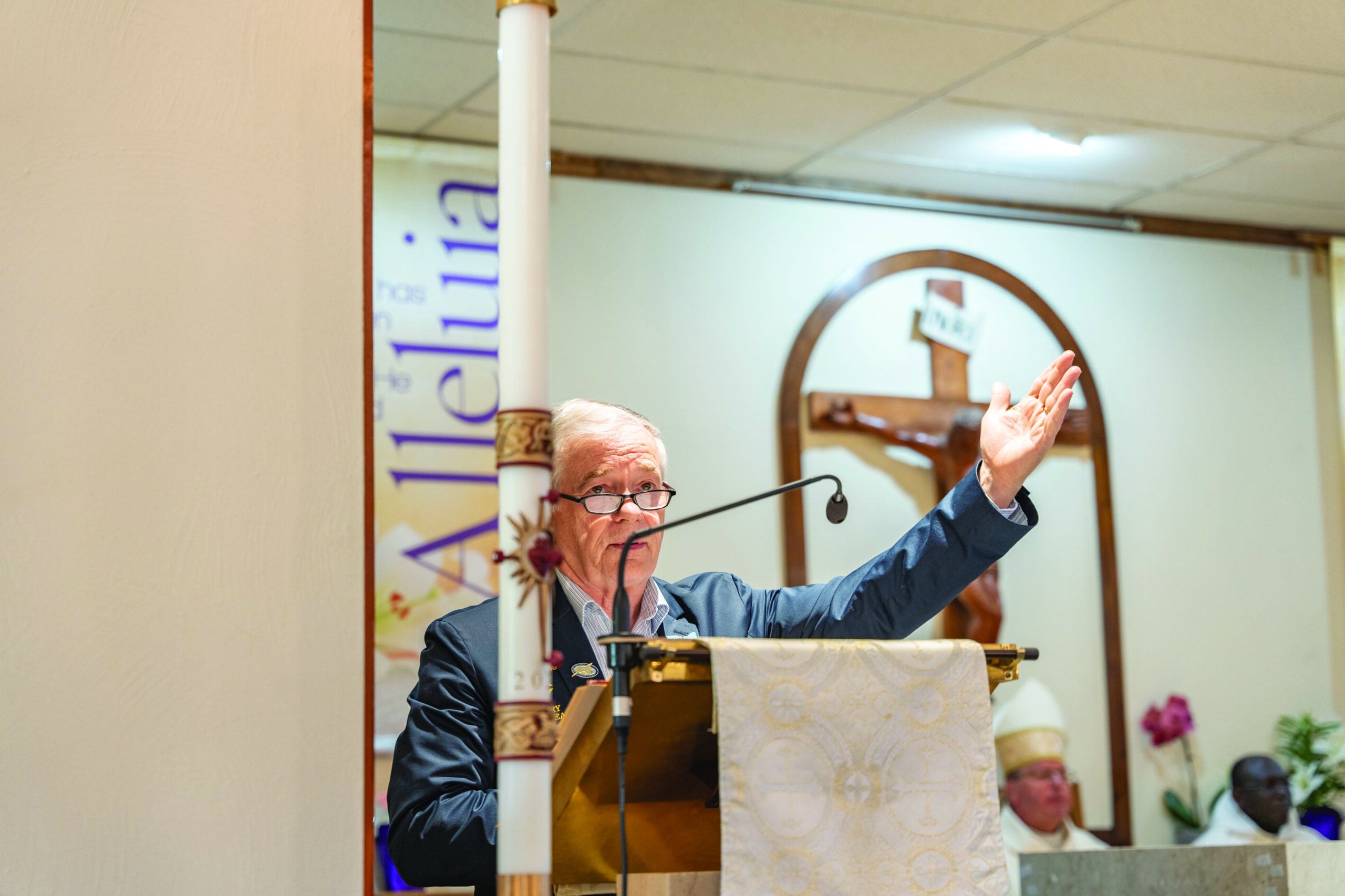
An Adult Faith
The Liturgy of the Word as Bishop Bonnar celebrates Mass at Sacred Heart Parish, Rock Creek. Photo by Brian Keith.
As we journey together on the road to heaven and are fed by God’s Word and Sacrament, it is important that we do not become complacent or stop growing. None of us can live an adult life on an eighth-grade faith. We need to be continuously led and fed in the faith, otherwise we will find ourselves leading shallow lives.
In our faith formation ministries, adult faith formation has taken on priority in recent years, and is indeed considered the “chief form of catechesis” (“Directory for Catechesis,” no. 77). The Church rightly continues to develop its important ministries of formation and accompaniment with children, youth, and families. Alongside these efforts, practical ways of helping adults grow in discipleship can include gatherings for adults of all ages (from young adults to seniors) and resources to help adults grow in faith at-home or while they are “on the move,” supported by parish libraries, seasonal booklets, curated multimedia websites, social media, and podcasts.
The Directory for Catechesis offers this vision,
“In the stages of adulthood . . . the faith itself is called to take different shapes, to evolve and mature, so that it may be an authentic and continual response to the challenges of life.”
Directory for Catechesis, no. 257
In my experience as a pastor, I have found that small faith groups, also called small Christian communities, are a primary way that we can do this, helping people name the presence of God in their lives and then continue to grow as Christian disciples. I renew my invitation, made in my first pastoral letter, for each parish to make the formation of small Christian communities a priority. Parishes should be creative in developing opportunities to share faith that are diverse in faith topics and that respond to every stage of the life journey, so that the Church can continue to “elicit faith,” “purify faith,” “nourish faith,” and “assist the sharing and witness of faith” (“Directory for Catechesis,” no. 261).

Practical Applications
From Coronation of the Virgin with the Trinity and Saints, c. 1440 Olivetan Master (artist) Lombard, active c. 1425 – c. 1450 Public Domain Open Access Image. Courtesy National Gallery of Art, Washington, D.C.
FAITH IS A GIFT that needs to be nourished. The family, “the domestic Church,” is often viewed as the greenhouse in which faith grows. My faith as a child blossomed in large part through my parents who introduced my siblings and me to Jesus Christ. Much of this learning took place by immersion. We watched how they lived their lives with trust, kindness, mercy, and love. We beheld the many sacramentals that adorned our home. We sat together at table for meals and regularly prayed grace. We shared our personal journeys in the light of the Gospel. Mom and Dad also taught us to pray. Before we would go to sleep or at the onset of long trips in the car, they would always bless us by saying three times, “Passion of Christ strengthen you.” When anyone in the extended family was ill, this blessing was often made with a crucifix that was a relic passed on through the family.
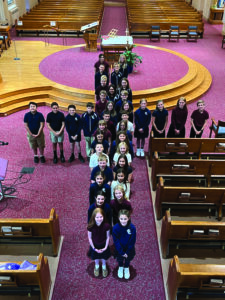
MY PARENTS TAUGHT US not only Christian values but the importance of belonging to a community of faith. The parish is the venue for this sense of belonging. Our faith was fed through attendance at Holy Mass every Sunday where we always sat in the first pew. As a child, I vividly remember asking mom when I was seated in that pew, “Where is God?” Without hesitation, mom pointed to the sanctuary. The five of us children were led deeper into a relationship with Jesus and the Church through Catholic Education.
AS WE EMBRACE THE FAITH, in this time and place and seek to plunge deeper into a relationship with Jesus and His Church it is important that we view the family and the parish as sources of nourishment and class- rooms of learning for the faith. While everyone’s experience of family and parish life is unique and nuanced, I maintain that the family and the parish remain foundational to the faith.
IN OUR TRADITION, parishioners are often called “the faithful.” Faith is to be part of our DNA. We cannot be authentic followers without faith. As bishop of this local Church, I call us to a renewed appreciation for faith. To that end, as we seek to grow in the virtue of faith, I offer the following goals.
A GRATEFUL FAITH
All that we have and all that we are is a gift from God. We are never entitled, only blessed. As a result, I invite us all to embrace a more intentional posture of gratitude not only with God but with each other. When I was a pastor, a retreat leader encouraged several concrete gratitude practices that have continued to stay with me: a phone call, text, thank you card, or personal visit can go a long way in expressing gratitude. He also encouraged us to consider starting a “gratitude journal” as a way of reflecting on those people and experiences for which we are grateful.
A Growing faith
If we behold the image of faith as a seed and a sign of life, then it is something that demands care and nourishment. Every Catholic in this diocese needs to assume greater responsibility for the growth of their faith and relationship with Jesus and the Church. Jesus does not want us to be bystanders or spectators but active participants in a relationship with Him. He is counting on us to continue his mission.
A confident faith
Before the Roman Missal (containing the words we pray at Mass) was modified, it was our custom before praying the Lord’s Prayer at Holy Mass to hear the priest say, “Let us pray with confidence to the Father in the words our Savior gave us.” Although that introduction is no longer used, our prayers must not lack confidence. Confidence can make such a difference. The confidence that we are to exude is one of a trust that knows God is in charge and always knows what is best for us. The confidence also comes in knowing that we will not be left orphaned.
A united faith
There is nothing Jesus desires more for us than to be one. In his great priestly prayer, he prayed, “That all may be one” (John 17:21). Jesus desires us to be one in the faith. This does not mean uniformity in person, family, or parish. It means that we see ourselves as a community of believers who care for one another even in moments when we see things differently. It also means that we keep our eyes fixed on Jesus and continue our shared journey to the fullness of eternal life.

Questions
for Reflection and Discussion
From Coronation of the Virgin with the Trinity and Saints, c. 1440 Olivetan Master (artist) Lombard, active c. 1425 – c. 1450 Public Domain Open Access Image. Courtesy National Gallery of Art, Washington, D.C.
Faith is a “supernaturally infused gift” (“The Light of Faith,” no. 7). How was this gift first fostered in you: through parents, friends, godparents, sponsors and/or faith communities?
How would you describe challenges to your faith right now: do you experience a doubting faith? A questioning faith? An impatient faith?
How do you accept “responsibility” as a person of faith, co-responsible for the mission of the Church and as a witness to God’s love in the world? What are you called to? Have you been called to “see in a new way?”

CHAPTER TWO
Living Together with Newfound Hope
From Coronation of the Virgin with the Trinity and Saints, c. 1440 Olivetan Master (artist) Lombard, active c. 1425 – c. 1450 Public Domain Open Access Image. Courtesy National Gallery of Art, Washington, D.C.
“FOR I KNOW WELL THE PLANS I HAVE IN MIND FOR YOU—ORACLE OF THE LORD—PLANS FOR YOUR WELFARE AND NOT FOR WOE, SO AS TO GIVE YOU A FUTURE FULL OF HOPE.“
JEREMIAH 29:11

Living Together with Newfound hope
Two years ago, on the eve of my ordination and installation as the sixth bishop of Youngstown, I gathered with the Apostolic Nuncio and the clergy in St. Columba Cathedral, the Mother Church of our diocese, for my profession of faith and oath of fidelity. In the context of that Evening Prayer, I preached on the words of the prophet Jeremiah to whom the Lord said, “For I know well the plans I have in mind for you—oracle of the Lord—plans for your welfare and not for woe, so as to give you a future full of hope” (Jeremiah 29:11).
In that solemn vespers I echoed the hope of Jeremiah and invited us all to embrace it. I also referenced the power of encounter presented by Pope Francis in The Joy of the Gospel. I said, “In this time of transition wherever we might be in our relationship with God or the Church, however we might feel about our vocation or work, this is our moment, a new moment, to encounter and be encountered by Jesus. Working together one by one we can make a difference” (Vespers Service at St. Columba Cathedral, January 11, 2021).
Hope is an essential mindset for Christians, and one we need to embrace in a world that tends to focus on what’s wrong and what’s not there. Christian hope does not ignore the difficulties of the world, but opens us to a positive mindset, seeing the possibility of what is right with the world. Even when the world is darkest, there is light.

Easter Hope in Hard Times: Alleluia is Our Song
The Liturgy of the Word as Bishop Bonnar celebrates Mass at Sacred Heart Parish, Rock Creek. Photo by Brian Keith.
In our lives, and in our time, there is a tug of war between hope and despair which could also be framed as trust versus suspicion. As Christians we are a people of hope, for as Saint Augustine reminds us, “We are an Easter people and Alleluia is our song.” The events of life, however, can sometimes keep us from singing.
The last ten to twenty years have been moments of crisis in the Church: from the clergy sexual abuse crisis to changes in our parish and Church life. At the same time, our society has experienced trauma, deeply felt here in Northeast Ohio: violence in our communities, the opioid crisis, poverty, and the continuing effects of the pandemic which impacted our churches and distanced us from one another. In just this past year, our area has also experienced the trauma of a train disaster, which has evoked fear about unknown effects on the health of our people in East Palestine and surrounding areas. What is more, the deep divide in terms of dealing with these crises has affected us all in our religious communities. Amid this turmoil, it is tempting to become pessimistic and to lack hope.
Pope Francis calls us to say “No” to pessimism and hopelessness. In “The Joy of the Gospel,” the Holy Father writes,
“One of the more serious temptations which stifles boldness and zeal is a defeatism which turns us into querulous and disillusioned pessimists, ‘sourpusses.’ Nobody can go off to battle unless he is fully convinced of victory beforehand. If we start without confidence, we have already lost half the battle and we bury our talents.”
The Joy of the Gospel, no. 85

Hope and Prayer Life
Canton Central High School Students Pray at Mass, hosted at St. Joan of Arc Parish, Canton. Photo submitted by Stark County Catholic Schools.
How can we be the people who join the battle against pessimism (including the pessimism in our own hearts) and “keep hope alive” (“The Joy of the Gospel,” no. 84)? In his encyclical, “Saved in Hope,” Pope Benedict XVI noted that one important “school of hope” is prayer. He wrote,
“When no one listens to me any more, God still listens to me. When I can no longer talk to anyone or call upon anyone, I can always talk to God. When there is no longer anyone to help me deal with a need or expectation that goes beyond the human capacity for hope, he can help me.”
Saved in Hope, no. 32
In “Testify to the Light,” I likewise identified prayer as one of five priorities for the diocesan Church—indeed the first one I named. If we are to grow in an active faith and be rooted in hope, each of us must develop a prayer life that is both public and private. This is why I am so excited about the current Eucharistic Revival, which calls us to a deeper understanding and experience of the Real Presence of Jesus Christ in the Eucharist, participating more actively in the Holy Mass and in times of quiet prayer before the Blessed Sacrament. As I wrote in “Testify to the Light,” “I ask you to pray with me and for me for a listening heart. We live in a noisy world increasingly uncomfortable with silence. Together we need to root our lives in prayer and recapture the amazing power of silence so that we can listen.”
Prayer is a way of being in a relationship with God—Father, Son and Holy Spirit. Prayer can be a place of strength, hope, and peace as well as a place where we demonstrate again and again our love for God and one another. There is an old saying, “Seven days without prayer makes one weak.” If we do not pray regularly, our faith will be weak and our hope shallow.
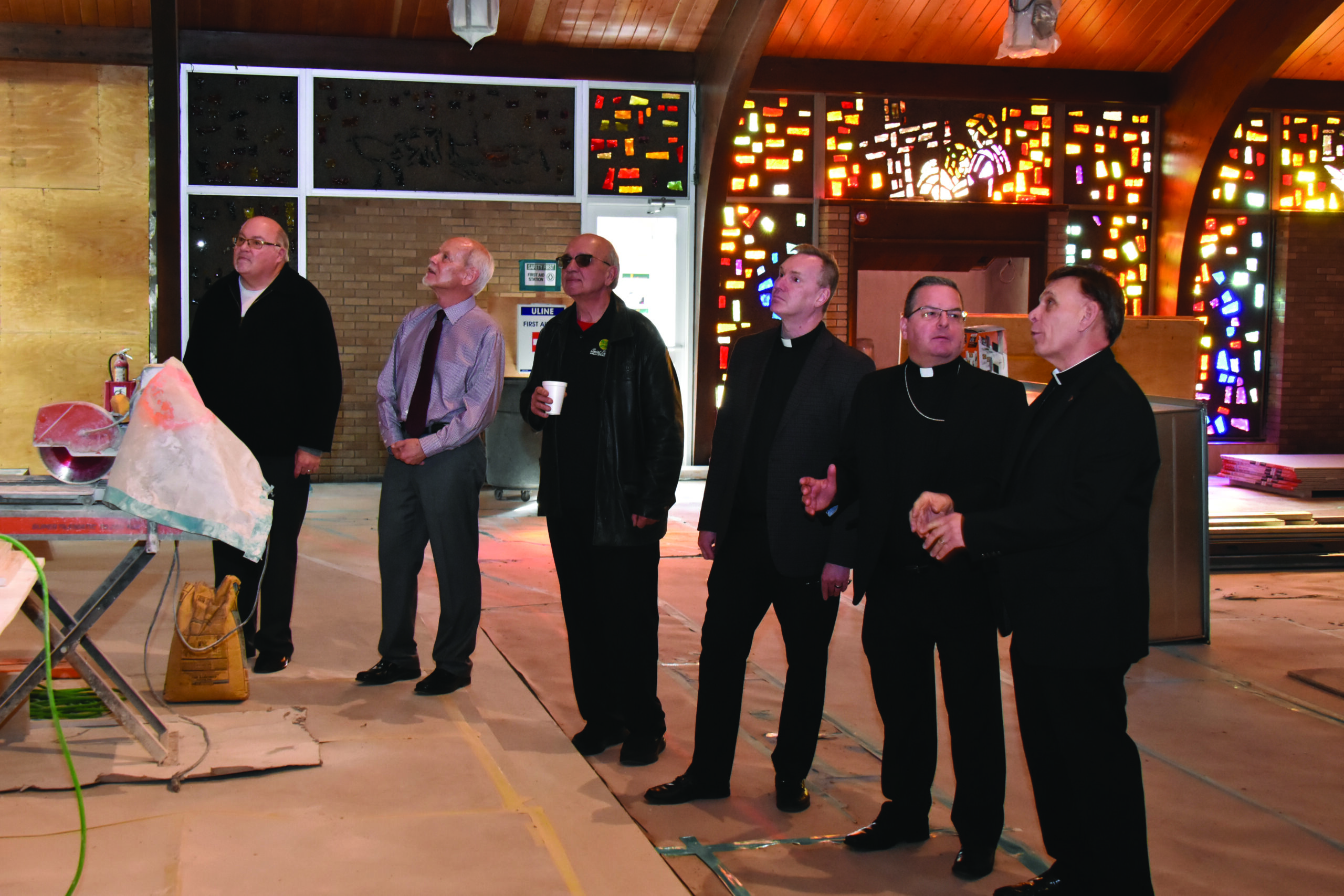
Hope, the Parish, and the Liturgy
Father Michael Swierz leads tour of St. Patrick Church, Hubbard, updating Bishop Bonnar on the reconstruction of the Church after fire damage. Photo by Robert Zajack.
One of my priorities as Bishop of Youngstown has been to walk with our parishes as we explore new ways of living parish life. I am more committed than ever to the parish as a wellspring of hope, and yet I know that people are struggling to find hope in parish life itself because it is not what it used to be. As Church we must discover anew that Christian hope is not fixed: it is dynamic not static, not nostalgic but forward thinking. Ultimately, our deepest hope is in a future beyond our imagination and beyond our time, with the fulfillment of the Kingdom of God. But even in our own finite lifetimes, our hope is in where God is leading us as Church here and now.
In “The Joy of the Gospel,” Pope Francis embraces this dynamic vision in words I never tire of repeating:
“The parish is not an outdated institution; precisely because it possesses great flexibility, it can assume quite different contours depending on the openness and missionary creativity of the pastor and the community. . . . if the parish proves capable of self-renewal and constant adaptivity, it continues to be ‘the Church living in the midst of the homes of her sons and daughters.'”
The Joy of the Gospel, no. 28
Quite simply, the Holy Father wants a parish that is close to its people— and after all, isn’t this sense of “closeness” that so many are yearning for in their parishes? The parish of today and tomorrow will be a source of hope to the extent that it is close to its people. To do this, our parishes must adapt to the needs of our people, especially those on the peripheries.
The Holy Mass, and our entire sacramental life, is a place of encounter with Christ who is our hope. Every time we gather for Holy Mass, we all walk in with our crosses, with the promise of walking out refreshed. Beginning with baptism, the sacraments are graced experiences where the “living water” of hope wells up in us (John 4:14). As a priest, I have been privileged to celebrate countless baptisms, first communions, and weddings as experiences of hope. The sacraments of reconciliation and anointing of the sick as well are powerful moments of hope for those who are suffering in mind, body, and spirit.

Hope and Vocations: Liturgy, Eucharistic Adoration, and Youth Ministry
Deacon John Rovnak and his family at a Seminarian Picnic sponsored by the Youngstown Vocations Support Society. Photo by Robert Zajack.
As bishop, ordination liturgies are particular moments of hope, for to ordain a man as a deacon or a priest is to experience the hope not just of the man kneeling in front of me, but of the entire diocesan Church ready for the days of ministry to come. At every ordination there is a sense of the fruitfulness of God’s grace, a harvest after much journeying and nurturing of this man’s vocation, and gratitude for all that this man will bring to the Church, an energy and breath of new life.
Studies over the past ten years from the Center for Applied Research in the Apostolate (CARA) tell us that priestly vocations flower directly from future priests’ activity in vibrant parish and liturgical life, especially through participation in parish youth ministries and as altar servers. The future hope we experience in ordination liturgies, therefore, is also a celebration of the importance of these ministries for both those being ordained and for all young people in the Church.
When it comes to prayer, these same CARA studies show a direct link between the prayer of Eucharistic Adoration and vocations. Among those who are ordained, Eucharistic Adoration is consistently their number one prayer practice year after year, including the last seven years in a row. All of the baptized have a role to play in nurturing both the practice of Eucharistic Adoration and vocations. When I was a pastor, with the help of the faithful I established a chapel for Eucharistic Adoration, along with a Parish Vocation Council whose task was to pray for, promote, and support religious vocations. They were intentional about praying before the Blessed Sacrament. In my time as pastor, four men entered priestly formation with two of the men now ordained priests and the other two continuing their formation. I have learned that two more men have entered the seminary with two more seeking application. There is also a woman who has entered religious life.
In our diocese we need to rediscover the graces that come from consistent Eucharistic Adoration, especially as we find ourselves in great need of religious vocations. I invite every parish to make Eucharistic Adoration part of their prayer life.
I also encourage the formation of parish vocation councils who will intentionally pray before the Eucharist for vocations. In a special way, I wish to thank our Deanery Vocation Support Committees for their important leadership, including the Youngstown Vocations Support Society in Mahoning County, the Vianney Cenacle in Columbiana County, and the St. Maximilian Kolbe Vocation Support Ministry in Portage County, and those currently in formation in each of our deaneries.
Sometimes we forget that God never stops calling men and women to serve the Church. Rather than simply pray for an “increase in vocations,” let us rather pray for courage and boldness, that each and every one of us might listen to how God is calling us to embrace priesthood, religious life, sacramental married life, or the single life. Eucharistic Adoration can be a privileged way to listen and respond with boldness and courage and make the words of a young Samuel the prophet our own, “Speak, for your servant is listening” (1 Samuel 3:10).
Eucharistic Adoration can also help us find meaning and new vigor to live our lives. In “The Joy of the Gospel,” Pope Francis states, “Without prolonged moments of adoration, of prayerful encounter with the word, of sincere conversation with the Lord, our work easily becomes meaningless; we lose energy as a result of weariness and difficulties, and our fervor dies out. The Church urgently needs the deep breath of prayer, and to my great joy groups devoted to prayer and intercession, the prayerful reading of God’s word, and the perpetual adoration of the Eucharist are growing at every level of ecclesial life” (no. 262).

Practical Applications
From Coronation of the Virgin with the Trinity and Saints, c. 1440 Olivetan Master (artist) Lombard, active c. 1425 – c. 1450 Public Domain Open Access Image. Courtesy National Gallery of Art, Washington, D.C.
LIKE FAITH, HOPE IS A SPECIAL GIFT that is integral to our lives. Hope is that reality that gives us confidence for the future, even when things may seem bleak. For us Catholics, this hope is found in God. In fact, some of the hymns we sing acknowledge God as our hope. For example, the hymn, “O God our Help in Ages Past,” notes that God is, “our hope for years to come.” We find the same statement in the hymn, “Lord of all Hopefulness.”
THE BLESSED MOTHER EMBODIES THIS HOPE as well under the title, “Our Lady of Hope.” The words of the angel at the Annunciation, “Nothing will be impossible for God” (Luke 1:37), no doubt invited Mary to hope during her own time of confusion and worry. Many of the faithful seek her intercession for this reason.
THIS SAME HOPE CAN BE FOUND IN THE LIVES OF MANY OF THE SAINTS. It is just as real and present today in the lives of others. Like the virtue of faith, I found hope in the domestic Church with my parents. In their own way, they taught the five of us children to exude hope no matter the circumstance. They also demonstrated to us the importance of listening to the right voices, namely, the voices of hope.
WHEN THE CLERGY SEXUAL ABUSE CRISIS FIRST BROKE in the early 2000’s I, like many people, felt demoralized and embarrassed. Of course, in no way could my hurt come close to that of those who were harmed by this horrific behavior. As men and women of hope, we need to keep praying for the healing of all victim-survivors of abuse and an end to this terrible scourge in all aspects of life. We also need to pray that despite their unspeakable disillusionment and loss, they never lose hope.
WHAT SAVED ME AT THAT TIME and gave me hope was the voices of the faithful at Sunday Mass. There were many a Sunday at Mass when, during the Creed, I found myself listening to the faithful profess the faith. Knowing that this evil had to be just as devastating to them, I gravitated to their words which gave me hope, not to mention their consistent presence at Holy Mass. Little did they know what an instrument of hope they were for me in my spiritual journey. Quite simply, in my time of darkness, they brought light.
ONE OF THE PARADOXES OF LIFE is that in the most trying times when it is so easy to lose heart, there is always an invitation to witness to hope. This moment can become the great tug of war. This struggle is articulated so poignantly by the author of the Book of Lamentations in the third chapter. The author speaks about the darkness of his life and how he has forgotten what happiness is. His life is deprived of peace without any hope. And yet, something happens. He says, “But this I will call to mind: therefore, I will hope. The Lord’s acts of mercy are not exhausted, his compassion is not spent; They are renewed each morning—great is your faithfulness! The Lord is my portion, I tell myself, therefore I will hope in him. The Lord is good to those who trust in him, to the one that seeks him; It is good to hope in silence for the Lord’s deliverance” (Lamentations 3:21-26).
IN THE FACE OF THE BAD NEWS and heartache that ripples through our lives there is always the good news that God never gives up on us. With God, there is always reason for hope. But sadly, in our impatience and frustration, we can give up on God. Nevertheless, as we aspire to grow in the virtue of hope, I present the following considerations.
A PATIENT HOPE
True hope is a posture of waiting that takes time for delivery. Unfortunately, we live in a world that has created an illusion of instants. We are led to believe that hope can be instant or happen according to our watch. Hope is a heart that continues to show up and patiently waits for God to break into our lives in God’s time.
A JOYFUL HOPE
In his Letter to the Romans, Saint Paul says, “Rejoice in hope . . .” (Romans 12:12). Essentially, Saint Paul is inviting the Romans to be joyful in hope. One can be joyful in hope because of God’s infinite love that extends to all. If we pause for a moment, we can behold this joyful hope in a child who joyfully hopes for Christmas or his or her birthday. I think that when Jesus says we need to become like a child to enter the Kingdom of God what he is saying, in addition to trust, is that we need to manifest continuously a joyful hope even in the face of the cynicism, sarcasm, and pessimism of the world.
A Resilient Hope
A resilient person withstands or overcomes challenges or difficulty. Such a person is often one who is flexible. A resilient hope is one that endures change, challenge, and disappointment. Such a hope overcomes adversity. Anyone who has ever competed appreciates the value of a resilient hope. A resilient hope is also one that is not afraid to stand alone.
A REALISTIC HOPE
One of the challenges of life from time to time is that of living in reality. Reality is not easy to accept at times. At some point, we come to discover that this place where we live, despite all its gadgets, buttons, and momentary beauty and bliss, and as much as we make it our home, is not heaven. We may experience from time-to-time heavenly moments, but this is not heaven. Not only can we lose sight of this fact, but we can also forget the heaven to which we are all called. A realistic hope is one that is spiritually grounded and views this world not as the end but as a shared journey toward the Kingdom.
A Shared Hope
Like faith, hope is not meant to be exclusive or kept solely to oneself. Hope is meant to be shared. Article no. 1817 of the Catechism of the Catholic Church teaches, “Hope is the theological virtue by which we desire the kingdom of heaven and eternal life as our happiness, placing our trust in Christ’s promises and relying not on our own strength, but on the help of the grace of the Holy Spirit.” The words “we” and “ours” reveal so poignantly this shared sense of hope.

Questions
for Reflection and Discussion
From Coronation of the Virgin with the Trinity and Saints, c. 1440 Olivetan Master (artist) Lombard, active c. 1425 – c. 1450 Public Domain Open Access Image. Courtesy National Gallery of Art, Washington, D.C.
In what ways have you experienced crises in recent years as moments of despair? Have there been people or moments who helped you to not ignore the difficulties of the world, but opened you up to a positive mindset: seeing the possibility of what is right with the world? Who have been the beacons of hope for you?
Have there been moments or practices of prayer – in public liturgy and/or times of silence and contemplation – that nurtured hope in you?
How would you describe your hope, or desire for hope, right now: a Patient hope? Joyful hope? Resilient hope? Realistic hope? Shared hope? What gives you reason for hope?

CHAPTER THREE
The Power of Love
From Coronation of the Virgin with the Trinity and Saints, c. 1440 Olivetan Master (artist) Lombard, active c. 1425 – c. 1450 Public Domain Open Access Image. Courtesy National Gallery of Art, Washington, D.C.
“I HAVE TOLD YOU THIS SO THAT MY JOY MAY BE IN YOU AND YOUR JOY MAY BE COMPLETE. THIS IS MY COMMANDMENT: LOVE ONE ANOTHER AS I LOVE YOU.“
JOHN 15:11-12

God is Love
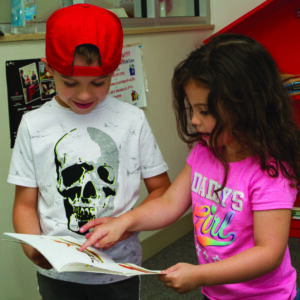
We know that Jesus is Love Incarnate, and where there is love, there is God. In “God Is Love,” Pope Benedict XVI reminds us that “Love is light—and in the end, the only light—that can always illuminate a world grown dim and give us the courage needed to keep living and working” (no. 39). Thus, when scripture tells us that “God is Love,” (1 John 4:8) we are meant to pause and reflect on an understanding of love that transcends personal experience. The simple sentence, “God is love,” provides a rich and complete context for this life, as well as a confident reassurance (hope) for the next life with God in the Kingdom of Heaven.
The word “love” is frequently used in our everyday interactions with others. “Love” can describe our profound fondness for everything and everyone— from pizza to our parents or children. The unintended consequence of such broad application is a depletion of the word’s meaning and impact.
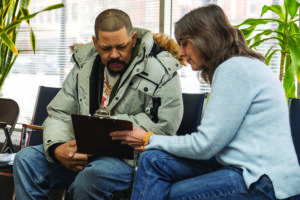
We know that love is so much more than a word we toss about in our daily conversations. Even Webster’s definition of love as “an intense feeling of deep affection” seems to fall short, since love has many forms, expressions, and levels of depth. In fact, love can be something new and different each day. It is fitting that several languages have more than one word for “love” depending on how it is intended.
Nonetheless, one truth remains: the word “love” has power—power to transform hearts of stone to hearts of flesh; power to bridge distances between people; and power to reveal the presence of the divine in our very midst.

Forgiveness and Mercy: the Fruits of Love
Baptismal Font at St. Thomas the Apostle Church, Vienna. Photo by Brian Keith.
However, the beauty and simplicity of love as God intends it can be complicated by our own pride and selfishness, as well as the negative influences in our world today. The interpersonal acts of mercy and forgiveness are required to restore love in relationships that have been damaged by sin, yet, too often, we are slow to offer these fruits of love when they are most needed (Luke 15:11-32).
The story of the Prodigal Son shows how both forgiveness and mercy are manifested in the unconditional love the father has for his son—echoing the love God the Father has for each one of us. After squandering his inheritance and returning home where he hopes his father will take him as a servant, the prodigal son begs for mercy:
“Father, I have sinned against God and against you. I am no longer fit to be called your son.”
Luke 15:21
The father, however, so overjoyed that his wayward son has returned home, commands a ring for the son’s finger and the preparation of a feast, “For this son of mine was dead, but now he is alive; he was lost, but now has been found” (Luke 15:24). With this statement, the son’s sins against his father have been forgiven and forgotten. Mercy has been requested and readily received. The fruits of love have healed a fractured relationship.
While mercy and forgiveness may be easier to bestow upon those we love, God asks and expects more of us. Jesus came into this world to teach us how to love one another, from our family and friends to strangers and those we find difficult to love. A humbling example of this selfless love is found when Jesus, crucified for our sake, passionately forgives those who persecute him saying, “Forgive them, Father! They do not know what they are doing” (Luke 23:34). Forgiveness in this most profound of circumstances reminds us that we must go and do likewise, reconciling with those who have hurt us and with those we have hurt; doing so allows us to be in right relationship with God.

Love is Presence
Eucharistic Procession at Christ the Servant Parish, Canton.
If we reject the fruits of forgiveness and mercy, we are living in darkness and not in the light of love. Some among us would rather accept that the pain that comes from broken relationships is simply part and parcel of being human. However, God does not want us to live in the loneliness and isolation that results from broken relationships.
When we practice forgiveness and mercy, both as givers and receivers of these graces, we can be authentic representations of God’s loving presence in the world.
Thus, as faithful people loved by God, we are to be purveyors of love in our place and time. At every celebration of Holy Mass, we are commissioned to go forth and share the love we have received. There is no room for indifference or self-isolation when it comes to love. Rather, love compels us to a ministry of presence and accompaniment; to walking with our sisters and brothers as fellow pilgrims on life’s journey. In “The Joy of the Gospel,” Pope Francis tells us that “Whenever we encounter another person in love, we learn something new about God. Whenever our eyes are opened to acknowledge the other, we grow in the light of faith and knowledge of God” (no. 272). Thus, through encountering and loving others, we are shown the direct pathway to God.
While we all desire to grow closer to God, we also know that sometimes loving others can be uncomfortable because it may bring us face to face with the wounds of Christ. Pope Francis reminds us in “The Joy of the Gospel”: “Sometimes we are tempted to be that kind of Christian who keeps the Lord’s wounds at arm’s length. Yet Jesus wants us to touch human misery, to touch the suffering flesh of others” (no. 270). When we show empathy, tenderness, and mercy to those who are suffering, we become the balm of love that heals and restores connections among the human family.
Those we reach out to might reject our efforts or might be hesitant to reveal the extent of their pain and suffering. However, we must persist in love. We must risk the vulnerability that comes from letting go, from not holding back, and allowing the Holy Spirit to animate us toward acts of charity and service—indeed, acts of love.
When we become living, breathing manifestations of love, we are truly free, less threatened by the forces of darkness and hopelessness that impinge upon our happiness and well-being. God’s love gives us the courage and desire to share our love with others. It also fortifies us to face the challenges of this world, confident that we have done our part to make God’s Kingdom come.

Practical Applications
From Coronation of the Virgin with the Trinity and Saints, c. 1440 Olivetan Master (artist) Lombard, active c. 1425 – c. 1450 Public Domain Open Access Image. Courtesy National Gallery of Art, Washington, D.C.
WHEN JESUS SPEAKS about love in the Gospel of John, he makes two very important statements. First, he says, “As the Father loves me, so I also love you. Remain in my love” (John 15:9). Jesus expresses his deep love for us and asks us to live our lives in that love. The knowledge that we are loved, not to mention the experience of being loved can make such a difference in one’s life. Second, Jesus challenges us to share this love. He says, “This is my commandment: love one another as I love you” (John 15:12).
LOVE IS MORE THAN JUST AN IDEA. It is a choice that usually reveals itself in an action of some kind. When I was a child, there used to be a cartoon that appeared in the daily newspaper. It was called, “Love is…” Everyday there was a sketch rendered by the artist of what love is. And every day love was something new and different. The takeaway in this for me was that love was always something more. Love simply cannot be limited.
SAINT PAUL HOLDS THAT LOVE is the greatest of the virtues. And yet, I think we all would agree in saying that love might be the most difficult of all the virtues to embrace. It is one thing to love those who love us, but to love those who do not like us or even those whom we do not love is a challenge. I read something on my episcopal retreat that essentially conveyed this sentiment: “A bishop must love all those whom he finds difficult to love.”
JESUS DEMONSTRATES THE FULLNESS OF LOVE at Calvary on the cross by sacrificing his life for us. He put actions to his words: “No one has greater love than this, to lay down one’s life for one’s friends” (John 15:13). Every time we come to Holy Mass the expression of this love is made real and present to us. And as we receive the Holy Eucharist, we are to go forth into the world to, in the words of Saint Augustine, “become what we receive.” We are to be Christ’s love to the world.
AS WE SEEK TO GROW IN THIS GREATEST OF VIRTUES, we need to behold the richness of love with its many faces. I encourage us to embody the following types of love in the nitty gritty of our lives.
An Intentional LOVE
If love is a choice, then it is something that we must intentionally choose each day. I invite us all to become more intentional in our love. This intentionality is expressed first and foremost in prayer in which we call on the love of God so that we might love as God loves. This intentionality is something that is to echo in our lives.
Like Jesus, we cannot be selective about love. Love does not allow for discrimination or prejudice. Sadly, there have been times when we have limited our love and made it exclusive for someone or something for one reason or another. To choose to love Jesus is to choose to love others, especially the poor and marginalized. Jesus brings this point home in Matthew 25 when he says, “And the king will say to them in reply, ‘Amen, I say to you, whatever you did for one of these least brothers of mine, you did for me’” (Matthew 25:40). The same can be said about what we fail to do. Jesus says, “He will answer them, ‘Amen, I say to you, what you did not do for one of these least ones, you did not do for me’” (Matthew 25:45).
A Concrete Love
In his Second Letter to the Thessalonians Saint Paul seeks to prepare the community for the day of the Lord which appears imminent. He prays that the love of God will overflow into their lives. He says, “May our Lord Jesus Christ himself and God our Father, who has loved us and given us everlasting encouragement and good hope through his grace, encourage your hearts and strengthen them in every good deed and word” (2 Thessalonians 2:16-17). As followers of Jesus Christ, love cannot be relegated to a good idea or a benevolent desire. Our love is to overflow into our words and deeds.
A concrete love is one of action. This action often takes the form of service. I am always so grateful for those in our diocese who support the Annual Diocesan Appeal: One in Hope, One in Mission. Our support of this Appeal is an act of love that enables Catholic Charities and the diocese through its parishes and ministries to continue the mission of Jesus. Of course, this concrete love transcends this Appeal and ripples through our diocese in a myriad of ways.
A COmpassionaTE LOVE
As a child in elementary school, I remember attending Stations of the Cross every Friday in Lent with my school community. One of my favorite Stations was the Fifth Station: Simon helps Jesus to carry his cross. For me the scene of Simon helping Jesus in his time of need illustrates compassion. Simon not only helps Jesus, but he tenderly suffers with him through support and accompaniment.
There are many people in our world and community suffering today. They are in need of our compassion. Close to home I think of the poor, the homeless, the incarcerated, the unemployed and underemployed, the sick, the elderly, and those who have suffered as a result of abuse, violence, exploitation, racism, prejudice, and injustice. It is important that as individuals but also together in our parishes that we help these suffering people. Catholic Charities is a compelling model and witness of compassionate love.
A Life-Giving Love
In John’s Gospel, Jesus says, “I came so that they might have life and have it more abundantly” (John 10:10). Jesus shows us that love is synonymous with life. To choose love is to choose life. True love generates, beholds, respects, and always safeguards life.
Jesus speaks not just about life but a more abundant life. As God’s children we are invited to a full life. But we are also called to share this abundant life through our love of one another.
The love and life that comes from Jesus is not meant to be hoarded or self-contained. And to those who have received much there is a responsibility to share generously. Jesus makes this very clear when he says, “Much will be required of the person entrusted with much, and still more will be demanded of the person entrusted with more” (Luke 12:48). As bishop of this local Church I am deeply grateful to those who answer this call to be life-giving in their love. One tangible way that this love and life unfolds in our diocese is through those called to priesthood, religious life, married life and the single life. In “The Joy of the Gospel,” Pope Francis notes, “Wherever there is life, fervor, and a desire to bring Christ to others, genuine vocations will arise” (no. 107). In our love for the Church I again ask that we all intentionally pray more for an abundance of life in vocations.
An Unexpected LOVE
In “The Joy of the Gospel,” Pope Francis writes, “Being a disciple means being constantly ready to bring the love of Jesus to others, and this can happen unexpectedly and in any place: on the street, in a city square, during work, on a journey” (no. 127).
Love must not always be relegated to heroic acts. Love happens just as poignantly in the small stuff of ordinary life. Every moment, every breath offers possibilities to radiate God’s love. When this love is expressed unexpectedly, it is even more special. The God of surprises uses us every day in the ordinariness of life to unwrap the gift of God’s love.
A Bonding Love
Love is a dynamic force that can harness unity and concord. Jesus’ great prayer for us is, “That all may be one.” (John 17:21). This oneness comes at a cost as Jesus shows the depth of his love for us in pouring out his life on the cross. But in this loving and saving act, we are one.
Perhaps this is why Saint Paul viewed this virtue of love as the greatest of virtues inasmuch as it enables us to realize the great priestly prayer of Jesus, “That all may be one.”

Questions
for Reflection and Discussion
From Coronation of the Virgin with the Trinity and Saints, c. 1440 Olivetan Master (artist) Lombard, active c. 1425 – c. 1450 Public Domain Open Access Image. Courtesy National Gallery of Art, Washington, D.C.
In “The Joy of the Gospel,” Pope Francis states, “. . . if I can help at least one person to have a better life, that already justifies the offering of my life” (no. 274). What do you think our Holy Father means by this statement? Reflect on relationships in your own life. Are there people you have helped “to have a better life” through your expression of love and concern? Describe this experience.
Do you find it difficult in today’s world to show mercy and forgiveness? Reflect on a time in your own life when you granted forgiveness to someone who hurt you. How did you feel after you forgave that person? What was the other person’s reaction to your forgiveness?
What do the words“presence,” “encounter,” and“accompaniment” have to do with love? Are all three required in order for love to be shared? Explain your opinion.
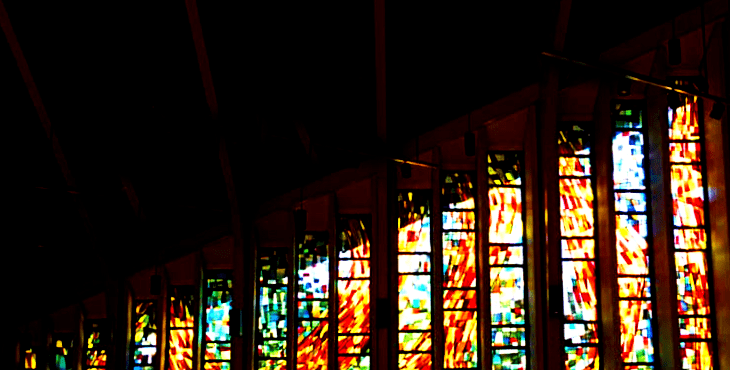
ConclusION
PRACTICING FAITH, HOPE, AND LOVE
There is no doubt that within every time and place there are inevitable challenges. We know so well here in Northeastern Ohio the difficulties that are ours. Indeed, these are tough times! And yet, this moment contains an array of opportunities. As Catholics living in this portion of the Lord’s vineyard this is our moment to intentionally testify to the light by practicing the virtues of faith, hope, and love. If we desire to endure the struggles of this world, it is imperative that we develop these Christian habits of the heart. If we seek to be true disciples and authentic Catholics, there is no other way but to grow every day in these Christian virtues, much as those who preceded us in the faith in this portion of the Lord’s vineyard. We cannot help but draw inspiration and strength from their witness to these Christian virtues.
Pope Francis has invited us to be a Church that is “Synodal,” which means a Church that “journeys together”—walking with one another and, even more so, walking with Christ who is the Way, the Truth, and the Life (John 14:6). Let us go forth and continue our journey together following in the footsteps of the many holy women and men before us and aspire to be people of faith, hope, and love, always trusting in the intercession of the Blessed Virgin Mary, a woman of faith, an exemplar of hope, and a mother of love.
Prayer of Commitment
God of Love, your Divine Life flows freely in our world, taking on human flesh through the power of the Spirit, calling us to journey together in following the Way of Jesus Christ. Strengthen us, sustain us, transform us anew.
Help us to live as true disciples, keeping our eyes fixed on our Savior’s path. Help us to embrace this moment with its many challenges and behold these not as stumbling blocks, but as stepping stones, to demonstrate who we are and whose we are. Bless us with the virtues of a strong faith, a steadfast hope, and an overflowing love.
Through the intercession of our Blessed Mother, a woman of faith, an exemplar of hope, and a mother of love, may we continue our shared journey and one day come to know the glory of the resurrection amid all our sufferings. May we see you, the author of life, the font of love, face to face.
Through our Lord Jesus Christ, your Son, who lives and reigns with you in the unity of the Holy Spirit, God, for ever and ever.
AMEN.
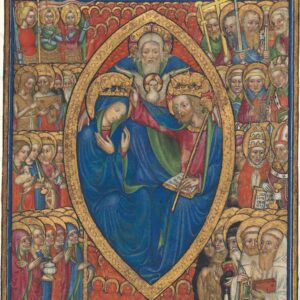
From Coronation of the Virgin with the Trinity and Saints, c. 1440 Olivetan Master (artist) Lombard, active c. 1425 – c. 1450 Public Domain Open Access Image. Courtesy National Gallery of Art, Washington, D.C.
